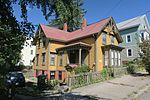Doyle Avenue Historic District

The Doyle Avenue Historic District is a predominantly residential historic district on the East Side of Providence, Rhode Island. It extends along Doyle Avenue from North Main Street in the west to Proctor Place (just short of Hope Avenue). This area was developed residentially between 1860 and 1920, with an architecturally diverse collection of houses (single and multi-unit dwellings), generally set on small lots with only modest setback from the sidewalk. Land on the south side of Doyle Avenue was owned by the Dexter Commission, which managed a large tract of land bequested to the city by Ebenezer Dexter. This land was originally leased to developers. One of the first houses built in this area was the c. 1875 Thomas Collins House at 33 Doyle Avenue, a 2-1/2 story Italianate duplex.The district was listed on the National Register of Historic Places in 1990.
Excerpt from the Wikipedia article Doyle Avenue Historic District (License: CC BY-SA 3.0, Authors, Images).Doyle Avenue Historic District
Doyle Avenue, Providence
Geographical coordinates (GPS) Address Nearby Places Show on map
Geographical coordinates (GPS)
| Latitude | Longitude |
|---|---|
| N 41.838611111111 ° | E -71.407222222222 ° |
Address
Doyle Avenue 44
02906 Providence
Rhode Island, United States
Open on Google Maps











